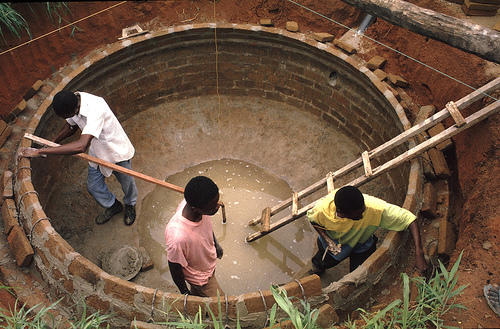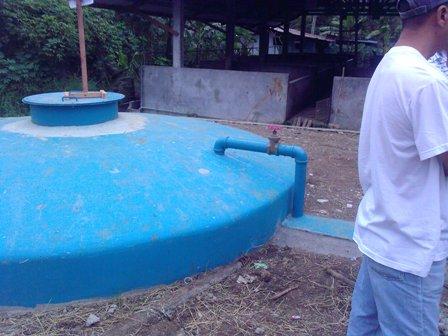Difference between revisions of "Practitioner's Tool / Biogas Systems"
(→Conclusion) |
|||
| Line 2: | Line 2: | ||
Biogas, which can be piped into homes and used for cooking fuel, is generated during the anaerobic digestion process. Human waste generates relatively low volumes of biogas, but when combined with animal manure and crop residue (biomass), the production of biogas is enhanced. Communities of just a few houses and animal pens or large communities of up to as many as 200 families can connect to the system and begin realizing benefits almost immediately. In this case, the community is defined by the slope of the land and the ability for families to connect their wastewater outlets through plumbing. Utilizing energy production from wastewater reduces reliance on more traditional sources of cooking fuel, and it burns cleaner too! | Biogas, which can be piped into homes and used for cooking fuel, is generated during the anaerobic digestion process. Human waste generates relatively low volumes of biogas, but when combined with animal manure and crop residue (biomass), the production of biogas is enhanced. Communities of just a few houses and animal pens or large communities of up to as many as 200 families can connect to the system and begin realizing benefits almost immediately. In this case, the community is defined by the slope of the land and the ability for families to connect their wastewater outlets through plumbing. Utilizing energy production from wastewater reduces reliance on more traditional sources of cooking fuel, and it burns cleaner too! | ||
| − | |||
| − | |||
Biogas generally refers to the gases produced from the microbiological breakdown of organic materials under anaerobic conditions. While biogas contains a host of different gases, it is the methane that contains the majority of the energy that can be captured for direct use in heating, or converted to electricity through a biogas generator. | Biogas generally refers to the gases produced from the microbiological breakdown of organic materials under anaerobic conditions. While biogas contains a host of different gases, it is the methane that contains the majority of the energy that can be captured for direct use in heating, or converted to electricity through a biogas generator. | ||
Revision as of 20:43, 12 October 2016
Biogas, which can be piped into homes and used for cooking fuel, is generated during the anaerobic digestion process. Human waste generates relatively low volumes of biogas, but when combined with animal manure and crop residue (biomass), the production of biogas is enhanced. Communities of just a few houses and animal pens or large communities of up to as many as 200 families can connect to the system and begin realizing benefits almost immediately. In this case, the community is defined by the slope of the land and the ability for families to connect their wastewater outlets through plumbing. Utilizing energy production from wastewater reduces reliance on more traditional sources of cooking fuel, and it burns cleaner too!
Biogas generally refers to the gases produced from the microbiological breakdown of organic materials under anaerobic conditions. While biogas contains a host of different gases, it is the methane that contains the majority of the energy that can be captured for direct use in heating, or converted to electricity through a biogas generator. Wastewater from animal operations, food processing and domestic septage contains enough organic matter to generate commercial quantities of biogas. Hog waste, for example, is strong enough that even small piggery operations or backyard hog raising can produce enough energy for use in the home for cooking or lighting. Slaughterhouse wastewater is another good example of a source of organic material that can generate high volumes of biogas. Slaughterhouses in the Philippines can generate enough biogas to run the facilities' scalding pots, which relates to a significant cost savings.
When combined, domestic septage and restaurant grease may also be a good source of biogas. Septage, or the contents of septic tanks, can have biochemical oxygen demands up to 50,000 milligrams per liter. When mixed with restaurant grease, septage can generate great quantities of biogas, although mixing is required. Other materials such as organic crop waste can also be added to increase biogas production. Performing bench-scale treatability studies prior to launching into full scale operations is recommended.
Contents
Biogas Wastewater Treatment Plants
Biogas systems, like other wastewater treatment systems, rely on components not only to treat the wastewater but also to deliver the raw waste to the treatment plant (sewer system) and send the treated effluent to the point of reuse or disposal. Equipment to store, capture and convert the generated biogas into usable energy is also required. Following are some of the components that make up a biogas wastewater system:
- Sewer system: The sewer, or the pipes in the ground, should be covered channels or enclosed pipelines that deliver the wastewater to the treatment system while excluding stormwater. Introduction of rainwater can dilute the waste and inhibit the volume of biogas generated. For existing facilities with open channels, covering the channels or installing closed pipelines may be necessary to ensure the viability of the biogas project.
- Collection tank: Waste from the sewer system enters the collection tank where it is homogenized and stored for delivery to the biodigester. Often, collection tanks are fitted with chopper pumps that break down larger solids in the wastewater to increase the efficiency of the treatment system.
- Biodigester: Biodigestion is an anaerobic process, so the process must occur in a sealed vessel. Some versions of the process use covered lagoons or waste stabilization ponds. O thers use tanks that may be buried partially or installed completely above ground. Pictured to the left is a partially buried biodigester constructed by C TRADE, a renewable energy company operating in the Philippines. This style of tank should be sufficiently large to accommodate 18 days of storage, which is an optimal residence time to maximize biogas production.
- Sludge processing: Sludge from the biodigester is rich in organic matter and nutrients, making it valuable as a soils conditioner or fertilizer. Proper biodigestion occurs at elevated temperatures and pH levels, which kills pathogens, making the sludge byproduct safe for use on both food and non-food crops. To process the bio-digested sludge, it must be dewatered (dried), sifted and bagged. Some fertilizer manufacturers add enzymes to the sludge to help stabilize it. Either way, sales of processed sludge as fertilizer is an important way to recover costs of the wastewater treatment equipment.
- Water recovery and reuse: The treated effluent, or what remains after the digestion process, is also a resource that can be reused under some circumstances. In a piggery operation, for example, the treated water is reused in the facility for washing the pens. While the water is anaerobic after digestion, it can still be used safely in the facility. If the treated water will not be reused in the facility, it must be treated further through aerobic processes prior to releasing it to the environment. Some suitable facilities include facultative or aerobic lagoons, constructed wetlands or mechanically aerated systems.
- Biogas storage: Storing the biogas is an important step as it allows use of the gas that is produced as it is needed, not only when it is generated. Often, gas production is not steady or constant as it depends on temperature and waste load, which may vary during the course of the day or week. The blue gas tank shown to the right is a steel tank installed in a water-filled concrete basin. As the tank fills with gas, it rises in the water column, and the weight of the tank helps compress the gas to between 3 and 5 psi. As the gas is used, the tank settles back into the water-filled basin. This tank is relatively inexpensive and can store up to 15 cubic meters of gas.
- Biogas reclamation: Shown to the right is a biogas engine that burns the gas and produces electricity. While the equipment is a bit expensive, it can be amortized over a period of years when the electricity savings can help recover the equipment costs. For example, a hog farm with 200 sows can produce enough electricity not only to run the wastewater treatment equipment but also to run other facilities at the farm like feed mills or lighting.
Putting it all Together
There are many different configurations of biogas wastewater systems and equipment. Developing the site will depend upon locations of open space, topography of the land, and discharge locations of the sewer systems. Often, wastewater treatment systems are constructed at the low point of the property to take advantage of the natural drainage of the sewer lines. The location of the sludge processing equipment is also important. Shown as the stepped infrastructure in the 3-D rendering below, the sludge processing area should be located down-gradient of the digester so that it flows by gravity from the digester outlet. Processing sludge with a minimum of energy inputs for pumping means there is more energy available for beneficial reuses.
Carbon Credit Sales
Typically, sources in developing countries sell carbon credits to polluters usually located in developed countries. While the payback can be large for well-thought-out projects, there are some difficulties. Below are some things to keep in mind when pursuing carbon credits sales:
- Projects must be developed as solutions to existing sites where biogas is being released to the environment with no controls. For example, if waste from a hog farm goes to a sewage lagoon with no gas collection, a biogas project that captures the gases prio r to release would be suitable for carbon credits as it solves an existing problem.
- Community members must be involved. Stakeholders meetings must be documented to verify local participation.
- Projects must be monitored carefully to verify that they are operated as intended. Credits can be lost if biogas generation is not properly documented. This certification process can be expensive as consultants from Europe or the United States are generally used to validate projects.
Conclusion
Biogas projects can have an important impact in reducing wastewater discharges to the environment while recapturing valuable resources to help cover costs. Fertilizer from digested sludge, treated effluent from the digestion process, and biogas used for direct or indirect energy can all help to cover the costs of the installation and operation of the system. Carbon credits may also be sold to further reduce costs if certain criteria are met.
For more information on biogas systems, visit C TRADE's website.




